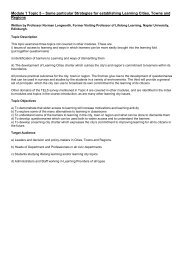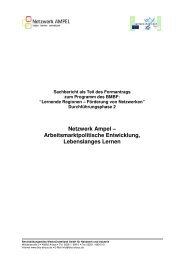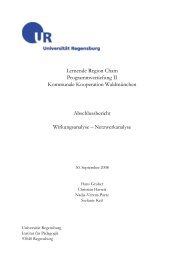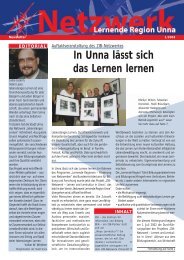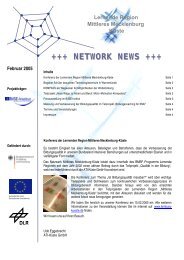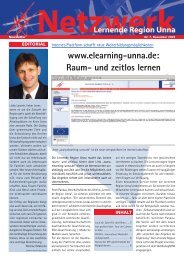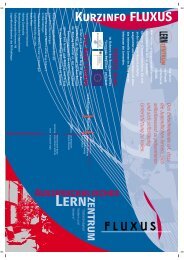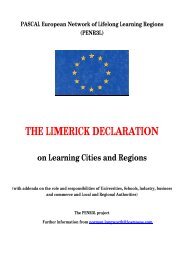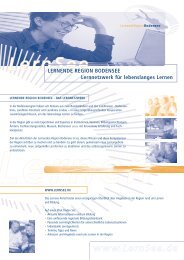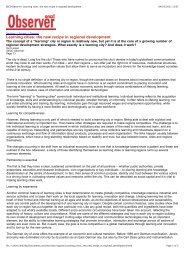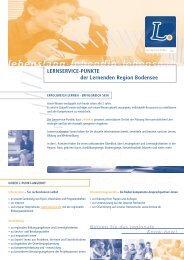SWOT-analysis as a basis for regional strategies - EUROlocal
SWOT-analysis as a basis for regional strategies - EUROlocal
SWOT-analysis as a basis for regional strategies - EUROlocal
You also want an ePaper? Increase the reach of your titles
YUMPU automatically turns print PDFs into web optimized ePapers that Google loves.
This stands in stark contr<strong>as</strong>t to the situation of public organisations. Public agencies<br />
frequently find themselves involved in a web of other actors, where they seek to<br />
promote the means that are seen <strong>as</strong> the best instruments to reach some agreed-upon<br />
goals (Karppi 1995). The setting of official goals, then, is usually a normative process<br />
and an outcome of an ideological campaign, taking place at the highest political<br />
levels. The aim of the organisations is to change the state of the environment in the<br />
world outside them, but they typically have direct access to only a fraction of the<br />
resources needed to bring about that change. Thus, they need the help of other actors,<br />
and this means that they need instruments with which to convince these actors and to<br />
create spheres of commitment to ensure that their interpretations of the public interest<br />
are worth adopting <strong>as</strong> a commonly shared goal.<br />
Normative goals within <strong>SWOT</strong> <strong>analysis</strong>: example of the Swedish Västerbotten<br />
Growth Agreement<br />
Often it is e<strong>as</strong>iest to agree upon the most general normative goals, whilst less political<br />
but highly sensitive re-distributive decisions become problematic. Many of the<br />
programming documents include horizontal domains of activity, which are apparently<br />
unproblematic in their normative requirements, but can become problematic when<br />
articulated into concrete me<strong>as</strong>ures requiring funding decisions. For instance, the<br />
Västerbotten Growth Agreement contains two horizontal domains of activity:<br />
ecologically sustainable development and equality, which are intended to permeate all<br />
programming work. This political choice is supported by the <strong>SWOT</strong> <strong>analysis</strong>, which<br />
implies the degree of centrality of the themes and the rationale behind their<br />
identification <strong>as</strong> strategic are<strong>as</strong> within the region in question. Many of the strengths<br />
(natural resources, environmental values) and weaknesses (out-migration, especially<br />
among young women, demographical and economic imbalances) are indeed<br />
connected to these two themes. Thus the <strong>SWOT</strong> <strong>analysis</strong> may also support certain<br />
more politically oriented choices in programming work.<br />
The extension of <strong>SWOT</strong> <strong>analysis</strong> into the area of the programming process and the<br />
institutional and organisational structures playing a key role within it often leaves<br />
room <strong>for</strong> improvement. In fact, in the Västerbotten programme the outlining of the<br />
equality theme within the programme is put in quite strong terms, emph<strong>as</strong>ising that<br />
work within the area of equality promotion is intended to “make visible the genderb<strong>as</strong>ed<br />
power structures, i.e. men’s relative dominant position and women’s relative<br />
subordination within the system”. It is argued that in order to change the gender-b<strong>as</strong>ed<br />
power structures within the region, a thorough <strong>analysis</strong> of the conditions, needs and<br />
interests of both sexes need to undertaken. An introduction of a particular<br />
“Västerbotten-model” of mainstreaming is included in the programme. It is also<br />
argued that the level of knowledge and consciousness about gender-perspective in<br />
decision-making needs to be augmented, in order to see how men and women are<br />
influenced by strategic decision-making within the county. The consideration of the<br />
equality dimension (<strong>as</strong> well <strong>as</strong> environmental sustainability) is included in the<br />
standard project evaluation. Whether this political commitment transcends the normative<br />
level of programming into the sphere of concrete activities remains an issue <strong>for</strong><br />
the evaluation process.<br />
23



